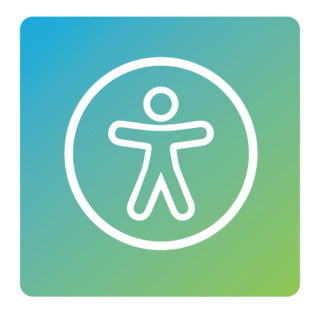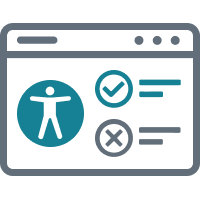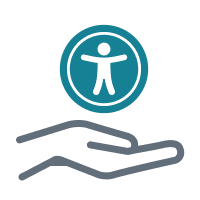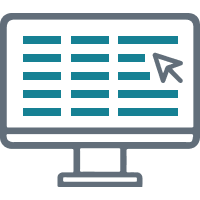- Home
- Thinking
- Tools and Resources
- Digital Accessibility Resources
- Digital Accessibility Glossary
Digital Accessibility Glossary
Welcome to our Digital Accessibility Glossary! As a leading UX and technical consultancy, we are dedicated to making the digital world accessible to everyone. This glossary provides clear definitions, and in some cases related resources on key accessibility terms and concepts. Whether you represent a government agency, enterprise, startup, or non-profit, these important concepts will help you understand key topics related to inclusive and accessible digital properties. Explore our glossary and don’t miss our Accessibility Services Digital Accessibility page and curated Accessibility Resources for more expert guidance and tools.

A
Accessibility
Accessibility, or in this case, digital accessibility specifically, refers to the degree to which a product, website, or application is inclusive of and usable by, the broadest range of individuals. Accessibility is most commonly measured by conformity with Web Content Accessibility Guidelines (WCAG). Digital accessibility is also sometimes called eAccessibility.
Additional sources and resources:
Accessibility Audit
An accessibility audit,sometimes referred to as an accessibility evaluation, is a service name for the process of evaluating a digital property's (e.g., website, app, digital product, etc.) accessibility. Typically an accessibility audit provides an in-depth evaluation of both the design and technical implementation against web accessibility guidelines (WCAG) and other principles.
Additional sources and resources:
- Limina’s Digital Accessibility services (including auditing and testing) and associated FAQs
Accessibility Conformance Report (ACR)
An Accessibility Conformance Report or ACR is the formal version of an accessibility Conformance Statement which is the industry standard for ensuring that a digital product or site is accessible. ACRs use the industry standard template known as the Voluntary Product Accessibility Template or VPAT. People often informally refer to ACRs as “VPATs”, in fact you’ll hear “VPAT” more often than “ACR” in the U.S. However, strictly speaking, the VPAT is the template, and ACR is the report that results from its use.
Additional resources:
Accessible Language
Accessible language is language that accommodates people of all ages and abilities, including those with cognitive disabilities, people with low literacy skills, and speakers of various languages.
Additional sources and resources:
- Ditch the Fancy Vocabulary for Accessible Language
- Use plain language, Harvard University digital accessibility resource for content creators
- Content and language by the community-driven Accessibility Designer Guide
Accessibility Dividend
Digital accessibility / eAccessibility tactics that reduce costs or improve the experience for all, as a side effect of systemic changes triggered by inclusive-by-default design thinking. The term curb-cut effect also refers to the idea of an accessibility dividend.
Additional resources:
- The ‘Curb-Cut Effect’ in the Digital Age: How Accessibility Tools Help Everyone
Assistive Technologies
Technologies (software or hardware) that increase, maintain, or improve the functional capabilities of individuals with disabilities when interacting with computers or computer-based systems.
Additional sources and resources:
- Health Topic: Assistive Technology by the World Health Organization
Audio Description
An auditory description (aka “descriptive video”) comprises audible words describing key visual aspects of what’s going on in a video not already apparent from the speech or sounds in the audio track (e.g., “location shot”, actions, body language, scene changes…), as a substitute for seeing the action. These are typically inserted in pauses in other audio (such as speech) and synchronized with the video, and are preferably in plain language.
Additional sources and resources:
B
Bias
A bias is a tendency, inclination, or prejudice toward or against something or someone. Biases are often based on stereotypes, rather than actual knowledge of an individual or circumstance. Whether positive or negative, such cognitive shortcuts can result in prejudgments that lead to rash decisions or discriminatory practices.
Bias is a natural inclination for or against an idea, object, group, or individual. It is often learned and is highly dependent on variables like a person’s socioeconomic status, race, ethnicity, educational background, etc. At the individual level, bias can negatively impact someone’s personal and professional relationships
Additional sources and resources:
- Recognizing Personal Bias and Ableism, University of Massachusetts
C
Certification (Accessibility)
Respected bodies (such as the IAAP) certify people in eAccessibility skills. It is also technically correct to certify a digital product; however, to avoid confusion we instead use the terms “conformance” and “compliance” when feasible when discussing digital content
Additional sources and resources:
Community Centered Design (CCD)
Related to Human Centered Design (HCD), Community Centered Design is an approach that scales up the consolidated methods and tools of User Centered Design to community size. This consists of the designer understanding values and behaviours, and collaborating with the most active social communities in conceiving and developing solutions.
Compliance
Accessibility compliance is attained when digital properties and assets conform to accessibility standards, regulations, and policies.
Additional resources:
Conformance
We make products conform to standards (e.g. WCAG, PDF/UA)., reserving the word "compliance" for complying with regulations.
Additional resources:
Curb-cut effect
Universal design term identified by Stanford’s Angela Blackwell (2017) regarding how programs designed to benefit vulnerable groups, such as people with disabilities or people of color, often end up benefiting all of society.
Additional sources and resources:
- “Curb-Cut Effect” was coined by Angela Glover Blackwell in the SSIR
- The Curb-cut Effec from Stanford Social Innovation Review (SSIR)
- Angela Glover Blackwell biography on PolicyLink
D
Diversity
Diversity includes knowing how to relate to qualities and conditions that are different from our own and outside the groups to which we belong, yet are present in other individuals and groups. These include but are not limited to age, ethnicity, class, gender, physical abilities/qualities, race, sexual orientation, as well as religious status, gender expression, educational background, geographical location, income, marital status, parental status, and work experiences. We acknowledge that categories of difference are not always fixed but also can be fluid, we respect individual rights to self-identification, and we recognize that no one culture is intrinsically superior to another.
E
Equitable Design
Equity is a solution for addressing imbalanced social systems. Justice can take equity one step further by fixing the systems in a way that leads to long-term, sustainable, equitable access for generations to come. According to the World Health Organization (WHO), equity is defined as, “the absence of avoidable or remediable differences among groups of people, whether those groups are defined socially, economically, demographically or geographically.” Therefore, as the WHO notes, health inequities involve more than lack of equal access to needed resources to maintain or improve health outcomes. They also refer to difficulty when it comes to “inequalities that infringe on fairness and human rights norms.”
I
Inclusion
The term inclusion is used to describe the active, intentional, and ongoing engagement with diversity -- in people, in the curriculum, in the co-curriculum, and in communities (e.g., intellectual, social, cultural, geographic) with which individuals might connect.
Inclusive Design
Inclusive Design is a methodology, born out of digital environments, that enables and draws on the full range of human diversity. Most importantly, this means including and learning from people with a range of perspectives. Inclusive design doesn't mean you're designing one thing for all people. You’re designing a diversity of ways to participate so that everyone has a sense of belonging.
Inclusive Language
Inclusive language seeks to treat all people with respect, dignity, and impartiality. It is constructed to bring everyone into the group and exclude no one. Inclusive language avoids biases, slang, or expressions that discriminate against diverse groups of people.
Intersectionality
Intersectionality is the interconnected nature of social categorizations such as race, class, ability, and gender as they apply to a given individual or group. It is a sociological framework identifying overlapping and interdependent systems of discrimination, disadvantage, and privilege. It focuses on the concept that people are not one thing and that different situations like inequality can compound to create unique obstacles.
Additional sources and resources:
- Merriam-Webster definition of intersectionality
L
Lived Experience
Personal knowledge about the world gained through direct, first-hand involvement in everyday events rather than through representations constructed by other people.
M
Marginalized Communities
Marginalized communities are those excluded from mainstream social, economic, educational, and/or cultural life.
N
Neurodivergent
Neurodiversity includes a variety of differences in individual brain functionality and human traits, which can include conditions like ADHD, dyslexia, social anxiety disorders, autism and more.
P
Product Inclusion
Product Inclusion is the practice of bringing an inclusive lens throughout the entire development and design process to build better products and grow business. It looks at 13 dimensions of diversity and the intersection of those dimensions.
T
Tokenism
The policy or practice of making only a symbolic effort (as to desegregate); the practice of doing something (such as hiring a person who belongs to a minority group) only to prevent criticism and give the appearance that people are being treated fairly.
U
Universal Design
Universal design is the process of creating products that are accessible to people with a wide range of abilities, disabilities, and other characteristics. Universally designed products accommodate individual preferences and abilities; communicate necessary information effectively (regardless of ambient conditions or the user's sensory abilities); and can be approached, reached, manipulated, and used regardless of the individual's body size, posture, or mobility. Application of universal design principles minimizes the need for assistive technology, results in products compatible with assistive technology, and makes products more usable by everyone, not just people with disabilities. Typically, products are designed to be most suitable for the average user. In contrast, products that are designed according to principles of universal design are designed to be usable by everyone, to the greatest extent possible, without the need for adaptation or specialized design.
W
Web Accessibility
Web accessibility means that websites, tools, and technologies are designed and developed so that people with disabilities can use them.

Accessibility Services
Discover how we can help make your digital property inclusive and conformant.

Accessibility Resources
Access our curated list of resources to support your digital accessibility initiatives.

Accessibility Planning
Download our FREE tool to better understand your accessibility needs and create informed RFPs.